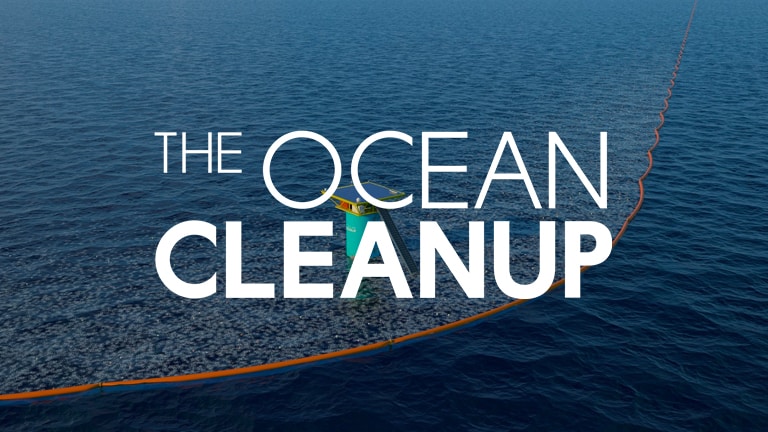THE OCEAN CLEANUP UNVEILS PLAN TO ADDRESS THE MAIN SOURCE OF OCEAN PLASTIC POLLUTION:RIVERS

The Ocean Cleanup aims to tackle the 1,000 most polluting rivers, responsible for about 80% of ocean plastic pollution, before the end of 2025.
Rotterdam, the
Netherlands – October 26, 2019 – The Ocean Cleanup, the Dutch non-profit organization
developing advanced technologies to rid the world’s oceans of plastic, unveiled
today its invention to prevent the unrelenting flow of plastic pollution into
the world’s oceans. The Interceptor™, under development by The Ocean Cleanup
since 2015, complements the organization’s founding mission by attacking the
flow of plastic garbage at its source, the world’s vast network of rivers.
“To truly rid the oceans of plastic, we need to both clean
up the legacy and close the tap, preventing more plastic from reaching the
oceans in the first place. Combining our ocean cleanup technology with the
Interceptor™, the solutions now exists to address both sides of the equation,”
said Boyan Slat, Founder and CEO of The Ocean Cleanup.
The Interceptor™ is the first scalable solution to intercept
river plastic pollution and can be deployed around the world. It is capable of
extracting 50,000 kg of trash per day – even reaching 100,000 kg per day under
optimized conditions.
Four Interceptors™ have been built to-date; two systems are
already operational in Jakarta (Indonesia) and Klang (Malaysia). A third system
is in Vietnam to be installed in Can Tho in the Mekong Delta (Vietnam), while
the fourth is destined to be deployed in Santo Domingo (Dominican Republic). In
addition to these locations, Thailand has signed up to deploy an Interceptor™
near Bangkok, and further agreements are nearing completion including one in LA
County (California, US), kick-starting the scaleup.
A Scalable and
Affordable Solution to Address a Global Problem
As part of The Ocean Cleanup’s research to map the problem,
it was established that 1,000 of the world’s 100,000 rivers (1%) are
responsible for roughly 80 percent of the garbage entering the oceans. The
product of their global scientific measurement and modeling efforts has been
visualized in an interactive map that is accessible here.
The Ocean Cleanup Interceptor™ is environmentally friendly
and 100 percent solar powered, with onboard lithium-ion batteries that enable
it to operate day and night without any noise or exhaust fumes. The system is
anchored to the riverbed to utilize the natural flow of the river to catch the
plastic, and is designed for 24/7 autonomous operation, removing the need for
dangerous manual work. Its floating barrier that is used to direct the garbage
into the system only spans part of the river; it will not interfere with other
vessels and does not harm the safety, nor impede the movement of wildlife – critical
requirements when operating in major rivers. An internet-connected onboard
computer monitors the system’s performance, energy usage, and component health.
The Ocean Cleanup publicly presented these plans and
unveiled the Interceptor™ 004 at a live-streamed event in the Port of Rotterdam
[link]. At the start of October, The Ocean Cleanup announced it was successfully
capturing and collecting plastic in the Great Pacific Garbage Patch with its
System 001/B, a cleanup system that is currently undergoing continued
performance testing at sea. For more information about The Ocean Cleanup,
please visit: www.theoceancleanup.com
Supporting footage and further details on the Interceptor™
and The Ocean Cleanup’s river project can be found here: https://theoceancleanup.com/the-interceptor-unveil-press-kit/
ABOUT THE OCEAN
CLEANUP
The Ocean Cleanup develops advanced technologies to rid the
world’s oceans of plastic. Founded in 2013 by Boyan Slat, The Ocean Cleanup now
employs approximately 90 engineers and researchers. The foundation is
headquartered in Rotterdam, the Netherlands.
Instead of going after plastic debris with vessels and nets
– which would take many thousands of years and billions of dollars to complete
– The Ocean Cleanup plans to deploy a fleet of long floating barriers that act
like an artificial coastline, enabling the winds, waves, and currents to
passively catch and concentrate the plastic. Once fully operational, the full
fleet of passive collection systems is expected to remove 50% of the Great
Pacific Garbage Patch every five years.
After years of conducting reconnaissance expeditions, scale
model tests and the deployment of prototypes on the North Sea, the first ocean
cleanup systems were deployed into the Great Pacific Garbage Patch in 2018 and
2019. Once proof of technology is achieved, The Ocean Cleanup can commence
full-scale cleanup and begin removing vast amounts of ocean plastic that have
been accumulating in the ocean for decades. The Ocean Cleanup is working with
partners to design processes to convert recovered ocean plastic into valuable
raw materials and durable products.
Complementary to its approach to solve the legacy problem of
plastic in the ocean garbage patches, the organization developed the
Interceptor™ technology to help prevent plastic garbage from entering the ocean
in the first place.





